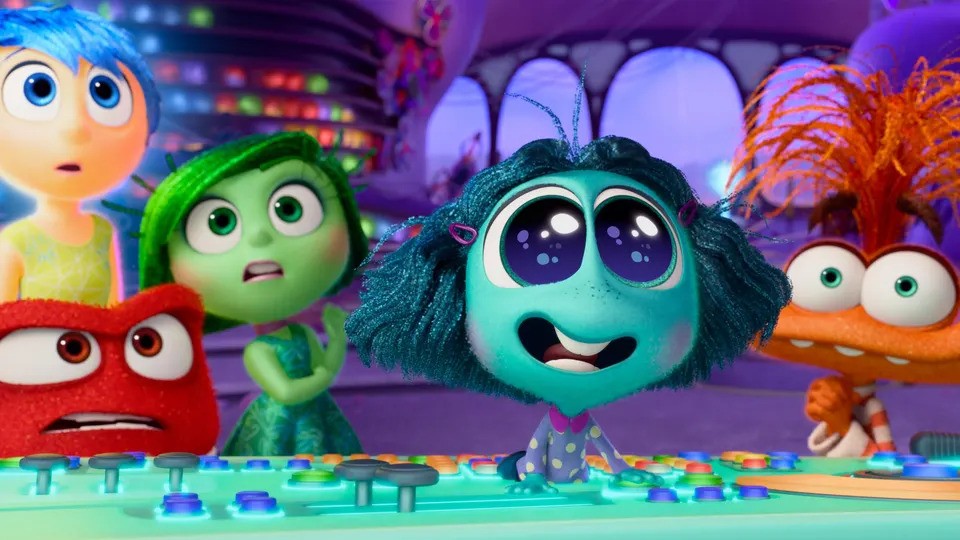Written by Margaret Rasberry on June 17th, 2024
When Pixar President Jim Morris announced that Pixar was shifting from autobiographical films to features with “mass appeal” it sparked a bit of discourse in online spaces. The studio that began with a feature inspired by John Lasseter’s own childhood belief that his toys came to life, was faced with a dilemma that films with autobiographical elements such as Luca, Turning Red, and Elemental (disregarding that two of these features were released on Disney + due to the pandemic, and Elemental earning twice it’s budget back by word of mouth, would be lessened in favor of mass appeal films, with sequels to Pixars’ most valuable IPs leading the charge in the rebranding of Pixar, with Inside out 2 (dir. Kelsey Mann) being the latest in this controversial endeavor. Inside out 2 is hilarious in many facts, with its creative expansion of the function of Riley’s mind serving as frequent highlights of the film, and endearing with the rapport built around the emotions and Riley with her friends, I could not help but feel like I was watching a well-crafted rehash of the original film, with the same lessons recapitulate with a brand new character, and this is a slight failing on the part of the film.
Riley (Kensington Tallman) is officially a teenager, and her emotions Joy (Amy Poehler), Sadness (Phyllis Smith), Anger (Lewis Black), Disgust (Liza Lapira) and Fear (Tony Hale) anticipating the next adventure in Riley’s journey to adult. The film sprinkles in a few tender moments with Sadness and Joy which conveys an endearing bond that has only grown more prominent in the two years since the original film took place. The plot begins when after Riley turns thirteen wrecking crew literally smash through the headquarters to enlarge the console with newer functions, an allegorical representation of puberty, with a literal puberty button loudly blaring. This heralds new emotions we have never seen before with Anxiety (Maya Hawke) leading the group consisting of Envy (Ayo Edebiri), Embarrassment (Paul Walter Hauser) and Ennui (Adèle Exarchopoulos) representing the newer developed emotions teenagers procure as part of their growth.
Not wanting to repeat her actions of the first film, Joy decides to let Anxiety take control for a bit, leading to the biggest conflict of the film as Anxiety hijacks the console and purges headquarters of Riley’s core emotions to the other side of her mind, and begins to unravel Riley’s core personality. Anxiety’s actions are compounded by Riley’s best friends and hockey teammates Grace (Grace Lu) and Bree (Sumayyah Nuriddin-Green) going to a different high school. Leading to literal anxiety that Riley will be friendless in high school, unless she is able to impress the Firehawks hockey coach Roberts (Yvette Nicole Brown) and star player Valentina (Lillimar) so that Riley will be a Firehawk player her freshman year with guaranteed friends, regardless if she loses her middle school friends along the way. Joy and the others must return to headquarters to undo Anxiety’s actions and save Riley’s core before it is too late.
Effusively endearing in multiple fronts, with immensely creative scenarios,that in many cases, surpasses the original film, and exquisitely detailed animation that makes you feel like you’re on the ice with Riley and her emotions but with each new setup the narrative pulls us in, little setbacks on camera and off threaten to unravel it and keeps the film from becoming another classic of the Pixar canon. Not even the stirringly complex voice work of Maya Hawke can negate this pertinent issue. Take for example Disgust and Fear, whose roles are expanded from the original film and with the new voice cast unable to give the same vocal inflections as Bill Hader and Mindy Kaling, who the animators drew much from when animating the characters, you get the jarring sense of something being amiss whenever they speak. It’s akin to hearing Dan Castelleneta voicing the Genie in one of the subpar Aladdin sequels; an adequate substitute, but a substitute nonetheless.
Another setback of the film is the inability to have Riley experience a more accurate depiction of cis girl puberty, with less focus on the physical, and frankly, disturbing facets of puberty compared to just the emotional, which the superior Pixar film Turning Red (2022) was able to accomplish much better but considering how Turning Red was considered by some to lack “mass appeal” for this reasoning it can be surmised the lack of going further into depth of puberty beyond anxiety, embarrassment, and ennui was a result of this approach. Inside Out 2 is a joyous experience for many, including this critic, that cannot shed the affixed issues plaguing its repetitive narrative structure and behind the scenes drama that will continue to stain the very brand Pixar was meant to represent.
Grade: B
